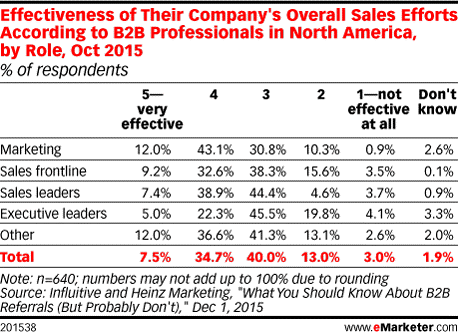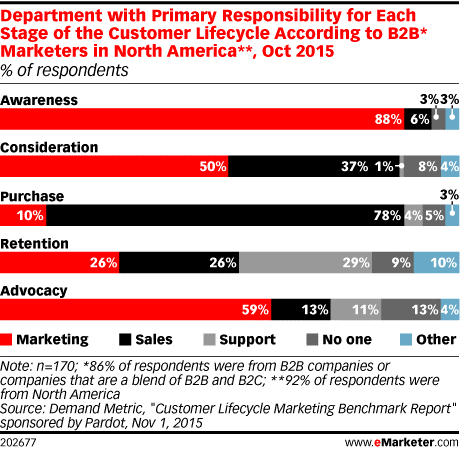24 March 2021
60% of salespeople assisted by AI and automation by 2021
AI and automation will be a staple of the B2B sales processs according to Forrester. Sales Enablement is booming in the US,…
18 October 2017
The digital transformation is in full swing in B2B companies but, beyond injecting a digital dimension into each function, this transformation entails reviewing internal organisation and, in particular, breaking the traditional silos formed by marketing and sales.
At a time when all CEOs are continuously claiming that the “digital transformation” of their company is underway, when you look under the bonnet, the situation is sometimes rather different. Digital is certainly omnipresent and the race is now on for marketing departments to see who will be the first to use the latest trendy social network. Are you not on Snapchat or WeChat yet? Don’t you know Never, the n°1 application in Korea?
On the product side, everyone must have a connected object and mobile application for their catalogue, even if the application is abandoned by the client within a few weeks. The important thing is to accumulate data on clients.
The sales department is not being left out. Performance culture is everywhere; sales performance indicators are the new bible. Sales people are connected, they have mobile applications and premium accounts on social networks but, ultimately, what has changed? Everyone probably works faster, more efficiently, but the organisation remains the same. Each department defends their teams and fights their own corners, and few companies really manage to get the marketing and sales departments to interact effectively.
A few months ago, the Qlik/EBG barometer highlighted shortcomings in terms of information sharing between marketing and sales departments, and the absence of shared metrics. eMarketer hammers the message home, publishing the results of a study recently carried out in the United States by Influitive and Heinz Marketing. The pollsters asked teams in B2B companies to grade the effectiveness of their actions as part of their company’s sales efforts. Globally, 40% of the employees asked deemed these efforts to be “average”. Only 12% of marketers and 7.4% of sales leaders judged them to be “very effective”. Ultimately, 5% of executive leaders claimed to be fully satisfied. Everyone has complete confidence that it is possible to do better but, if the diagnostic is made, how can we improve this score and stop missing sales opportunities?

Until now, everyone’s roles were clearly defined. It was up to marketing to cast their net far and wide over leads so as to feed the top of the sales funnel. It was up to the sales people to exploit these leads with an approach clearly focused on 1 to 1. This rational approach presents numerous side effects and ultimately results in a sales performance that is finally very “average”. Everyone is given goals, which are not necessarily in tune with those of the rest of the chain. The marketing department may very well lead extremely efficient actions and shower the sales people with leads… which really are too cold to be genuinely useful. Faced with this avalanche of contacts, sales people do not have the resources to contact them all and unthinkingly let real opportunities slip away. In the other sense, the marketing teams’ distance from the field means they may miss out on what’s changing in the market as well as those leads that are sometimes difficult to reach with traditional marketing tools.

In the dialogue with the client, there is a break in continuity depending on whether the client is dealing with the actions of the marketing department, the sales people or the support team. As highlighted by eMarketer, the client does not need to know the workings of the company they are dealing with. This is particularly true in the B2B sector: there has to be a continuum of dialogue with the client, even if this dialogue brings into play transversal resources in the company organisation. Businesses have more and more awareness and devote resources to certain major accounts or “premium” clients. But, more generally, in order to ensure a uniform “consumer journey”, it is clear that the way teams are used needs to be changed. This also means the implementation of transversal tools so as to share information related to the client with everyone who may take part in this “journey”, as the Americans like to call it.

This 360° vision of the client is more essential than ever as a pivotal service for this collaboration. Marketing needs the information gleaned in the field in order to trigger hyper-targeted actions. As for the sales people, they need to know which marketing actions their leads have been exposed to and perhaps their reaction to the opening of a promotional email, which white papers they have downloaded, etc.
It can be very pertinent, both for marketing and sales, to enrich this client repository of contextual data related to the company, its market and even the latest announcements by its director. The support team will also benefit from such a mine of information about a client.

Some solution providers are taking this idea to the extreme by transforming their CRM platform into a Facebook-type social network on which clients, sales people and marketing are able to interact. Facebook itself now lets you create your own internal Facebook, and many start-ups are reinventing work organisation on tools such as Slack.
Perhaps this is the future. In the meantime, however, it is urgent for general management to understand that this digital transformation must not limit itself to injecting a digital dimension into each existing function but that it should really “Uberise” the organisation itself.